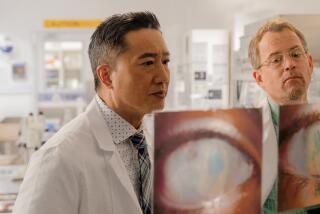TV REVIEW : Wiseman on ‘Deaf and Blind’
- Share via
Frederick Wiseman goes where most documentarians fear to tread. He’s arguably the most brilliant, brave and innovative person working in his field.
Sometimes, however, Wiseman goes where you’d just as well not follow.
The former teacher of law has documented nearly 20 American institutions--including a hospital, an Army base, a police department, a welfare office, a mental institute and a primate research center. This is a guy who’ll plop you down in the middle of a meat-packing plant to watch all the lovely things that go on there for two hours. That was in “Meat.”
His latest subject is the training of the sensory handicapped, and it’s covered in four films that PBS is showing under the umbrella title “Deaf and Blind.”
“Blind,” the first one (airing at 9 tonight on Channels 28 and 24 and at 10 p.m. Saturday on Channel 50), may be a title that heralds something almost as distressing and depressing as “Meat,” but this is not one of Wiseman’s documentary-as-ordeal deliveries.
In fact, though it may be difficult for hard-bitten Wiseman veterans to believe, Frederick the Great has made a film that could actually be called charming--even if it does start off as if it’s going to be anything but.
The first 10 minutes of “Blind” will severely test most viewers’ mettle. Not because of what happens, but because nothing happens. Or just about nothing: The school band from the Alabama Institute for the Blind visits an auto race track. We watch them unload their instruments; we see people in the stands, drivers on parade and lots of seemingly pointless shots. . . .
What’s going on here?
What’s going on is that Wiseman is dashing our TV-as-usual expectations and resetting our rhythms to Slow and our minds to Attentive.
As a result, we’re ready for the real film to begin--which takes place entirely at the institute from this point on, and shows how blind and partially sighted students, from kindergarten through 12th grade, are taught both basic and special skills.
It’s a deeply moving television experience--one containing more joy than heartbreak.
In typical Wiseman fashion--shunning narration, interviews and superimposed titles--”Blind” brings us almost tactilely close to the students and teachers for 2 hours and 12 minutes. The kids are easy to like, of course, as pity gives way to appreciation of their courage and independence, their persistence and differences. The big surprise, especially for a Wiseman film, is how wonderful the institution-managers--in this case teachers and administrators--turn out to be. “Blind” illustrates their care and dedication.
Some dedication from the viewer will pay off. And dedication is called for: In a Wiseman film, when you follow a blind kindergarten student’s slow, groping efforts to go down a hall, down a staircase and along another hall, you also wind up retracing the steps with him.
By this time, though, you not only should be slowed down to Wiseman’s pace but also fascinated with his subject--no longer saying “get on with it” but getting with it.
“Deaf and Blind,” (partially financed by a grant by the increasingly ubiquitous John D. and Catherine T. MacArthur Foundation), continues on KCET Channel 28 Saturday at 9 p.m. with “Deaf,” filmed at the Alabama Institute for the Deaf.
KCET will then show “Multihandicapped,” filmed at the Helen Keller School, next Friday at 9 p.m., followed by “Adjustment and Work,” filmed at the E. H. Gentry Technical Facility, on June 25 at 9 p.m.
“Deaf” airs on Channel 50 at 10 p.m. Sunday and on Channel 24 at 9 p.m. next Friday. Channel 50 will air “Multihandicapped” at 10:30 p.m. June 25.
More to Read
The complete guide to home viewing
Get Screen Gab for everything about the TV shows and streaming movies everyone’s talking about.
You may occasionally receive promotional content from the Los Angeles Times.






